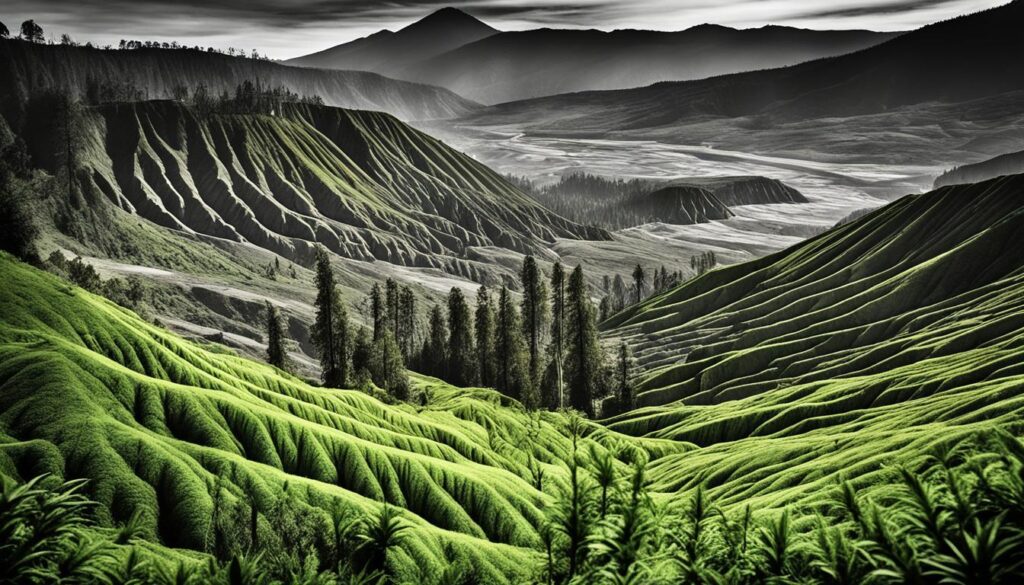Mount Bromo is a big volcano in East Java, Indonesia. It’s famous for its stunning views and unique land. People love seeing the active crater and the moon-like area around it.
The area has many types of weed that are important for the environment. This guide will tell you about weed in Mount Bromo. It will cover its importance, the types of weed, how it affects the environment, and how to keep the native plants safe.
Key Takeaways
- Mount Bromo’s unique volcanic landscape is home to a diverse array of weed species, which play a vital role in the ecosystem.
- Understanding the common weed species found in Mount Bromo is crucial for effective conservation efforts.
- Controlling unwanted vegetation while preserving native plant species is a delicate balance that requires responsible eradication methods.
- Exploring Mount Bromo’s unique flora can provide valuable insights into the region’s ecology and biodiversity.
- Responsible tourism and conservation efforts are essential to protect the fragile environment of Mount Bromo.
Introduction to Mount Bromo
Mount Bromo stands tall at 2,329 meters high. It’s a natural wonder that calls to those who love adventure. It’s an active volcano in East Java, Indonesia, part of the Tengger volcano group.
Mount Bromo’s Geological Significance
Mount Bromo is always active, sending out gas and ash. This activity shapes the land around it. It makes a world unlike any other, fascinating people for ages.
The Unique Volcanic Landscape
The volcano’s work creates a stunning view. You’ll see vast plains, rough lava fields, and changing light and shadow. It’s a place where adventure seekers and nature lovers come to see the earth’s power and beauty.
“The volcanic activity at Mount Bromo has given rise to a breathtaking landscape that is both serene and dynamic.”
Common Weed Species Found in Mount Bromo
Mount Bromo’s volcanic landscape is home to many weed species. These plants, like the Lantana camara, Imperata cylindrica, and Ageratum conyzoides, help hold the soil and protect native plants. They are key to the area’s ecosystem.
Knowing about these weeds is important for managing Mount Bromo’s ecosystem. We need to balance keeping the ecosystem safe with controlling weeds. Let’s look at some common weeds in Mount Bromo:
- Lantana camara – This weed grows fast and can take over native plants. Its bright flowers and quick spread make it hard to manage.
- Imperata cylindrica – Known as “cogon grass,” it thrives in many soils, including Mount Bromo’s volcanic ones. Its strong roots and fast growth are challenges.
- Ageratum conyzoides – Found in disturbed areas, it spreads quickly. Its many seeds and adaptability help it grow in Mount Bromo.
Even though these weeds can be invasive, they help the soil and protect native plants. Finding a balance in managing them is key. Land managers must be careful and thoughtful.
“Understanding the diversity and distribution of these weed species is crucial for developing effective management strategies that balance the preservation of the unique ecosystem with the need to control the spread of unwanted vegetation.”
Learning about Mount Bromo’s weeds helps us see how they interact with the land. This knowledge guides us in managing the land sustainably. It helps keep Mount Bromo beautiful and healthy.
Weed in Mount Bromo: Challenges and Concerns
Weeds in Mount Bromo cause big problems for nature and how we manage them. These weeds grow fast and can take over, pushing out the native plants. This changes the balance of nature, hurting animals and plants that live there.
Recently, forest and land fires in the Mount Bromo area on 6–15 September 2023 burned over 500 hectares of land. These fires make it easier for grass weeds to grow. This can change the area into grasslands, making the weed problem worse.
Dealing with weeds in Mount Bromo is hard because of its tough terrain. It needs special methods and a lot of work from groups that protect nature and local leaders. To fix the land after fires, we must know how different plants and forests work. This helps plants grow back and keeps nature in balance.
| Weed Species | Center of Origin |
|---|---|
| Lolium rigidum | Mediterranean region |
| Eleusine indica | Tropical Africa |
| Aegilops cyclindrica | Eastern Mediterranean |
Weed problems in Mount Bromo are not just there. A study in 1977 found 76 weed types worldwide. Many of these weeds have become resistant to weed killers, making it harder to control them.
“Yield losses due to grass weeds can reach up to 35% in the absence of herbicide use, affecting crops such as barley, maize, cotton, rice, sorghum, soybean, sugarcane, and wheat.”
Agriculture in Indonesia, near Mount Bromo, is important for jobs and the economy. But weeds and invasive plants can hurt farming and make it hard to grow food sustainably.

To fix the weed problem in Mount Bromo, we need to do many things. We must restore nature, use smart weed control, and get local people and conservation groups involved. Working together, we can save this special place for the future.
Controlling Unwanted Vegetation in Mount Bromo
Keeping Mount Bromo beautiful and healthy means we must deal with unwanted plants. These plants can harm the native plants and upset the balance of the area. They can even change the look of the volcanic landscape.
Responsible Eradication Methods
We need a plan to remove these plants safely. This plan includes pulling them out by hand, using herbicides carefully, and other safe ways. The goal is to stop these plants from spreading without hurting the environment.
It’s important to know which plants are bad and remove them. This stops them from taking over and hurting the native plants. By doing this, we can protect Mount Bromo’s plants and keep its nature safe.
Preserving Native Plant Species
We’re also working to bring back native plants to Mount Bromo. This helps fix the balance in nature and is good for the environment. It’s a way to deal with unwanted plants that helps the whole ecosystem.
By growing native plants, we help Mount Bromo’s nature and culture. This plan is key to keeping Mount Bromo’s plants safe for the future.

“Integrated weed management advocates for the sequential use of various control measures, including chemical, biological, cultural, and mechanical methods, to keep invasive plant damage below economic thresholds.”
Exploring Mount Bromo’s Unique Flora
Mount Bromo is more than just a place for weed. It’s full of different plants that live in the tough volcanic soil. You’ll see shrubs that don’t need much water and wildflowers that brighten up the area.
Scientists study the plants in Mount Bromo National Park. They learn how the plants and the volcano work together. They found many plants that can live in the dry, hard conditions of Mount Bromo.
- Drought-resistant shrubs, like Acacia and Euphorbia, grow on the rocky sides. They get water from deep in the soil.
- Wildflowers, including Lantana and Hibiscus, make the sandy areas colorful.
- Some plants, like the Rafflesia and Amorphophallus, are rare and need our help to survive.
Visitors to Mount Bromo should check out its plant life. It shows us how nature can survive in tough places. This helps us understand and care for Mount Bromo’s special plants.
“The flora of Mount Bromo is a living testament to the resilience of nature, showcasing how life can thrive even in the most inhospitable of environments.”
When you’re at Mount Bromo, look around at all the different plants. From big Acacia trees to small Hibiscus flowers, each one is important. They remind us why we must protect Mount Bromo and its plants.
Responsible Tourism and Conservation Efforts
Mount Bromo is getting more popular, so we’re focusing on sustainable tourism practices and conservation efforts. We want to keep the ecosystem balanced. Visitors should follow rules like staying on trails, not picking plants, and choosing eco-friendly tours.
Local groups and environmental organizations are working hard. They watch how people affect the area, manage weeds, and teach people why we must protect Mount Bromo. They want everyone, visitors and locals, to care for the environment. This way, Mount Bromo’s beauty and nature can be enjoyed for years to come.
Sustainable Practices for Visitors
To protect Mount Bromo, visitors should do these things:
- Stay on marked trails to avoid harming the land and plants.
- Don’t pick or disturb the plants, they are important for the area.
- Choose tours that care for the environment and respect local ways.
- Throw away trash properly and don’t litter, it hurts the animals and plants.
- Respect the local culture and traditions.
By following these tips, visitors help protect the unique natural wonders and cultural heritage of Mount Bromo. This way, everyone can enjoy its beauty and importance for a long time.
“Sustainable tourism is not just a trend, but a necessity to protect the delicate ecosystems and cultural treasures that make destinations like Mount Bromo so unique and captivating.”
Mount Bromo is working with local people, groups, and travelers who care for the planet. They aim to keep a good balance between tourism and nature. This way, the natural and cultural beauty of Mount Bromo stays safe for all who visit.
Conclusion
Mount Bromo is a place of beauty and unique plants. It attracts visitors from all over. But, there are challenges with weed that affect the area’s balance. We must work to keep the area safe for its plants.
By supporting good tourism and conservation, we can help Mount Bromo. This guide has shown us how to protect and enjoy this special place. It’s all about weed in Mount Bromo and how we can keep it safe.
Keeping Mount Bromo safe is key. We need to manage it well and work with the local people. This way, we can keep its beauty for the future. Supporting good practices helps a lot.
As you leave Mount Bromo, remember its beauty and what you learned. Think about the views and the need to protect nature. Your support is crucial for keeping this place special.

As a veteran weed smoker for over 30 years and been very clean for the last 3 years, I have been craving it.
One thing I’ve never done is consume it?
I came across SunJet Plug and thought mmmm how esp with legalities etc.
So I made the plunge and purchased 12 brownies, well within 30 mins it kicked in and it was immense as I had a whole one from the off 😜
The rest did not last a week I was having 2 a day and my wife lost me for a few days I was in my own world apparently.
Kudos to the Sunjet plug love em, the taste is a bit undesirable could do with a tweak or two other than that no complaints
Contact him on his telegram link: t.me/sunjetplug
His email : sunjetplug@gmail.com
Many many thanks.😁
Take note ,he does not have telegram channels
Sunjet plug is 100% legit.. I’m a repeat customer.. I’ve ordered 10+ times now, and I’ve never had an issue.. Great product, great service.
Sunjet plug is extremely trust worthy , they never fail in what ever product I order, and its always in my hands with an hour of ordering 99% of the time….. its honestly rare when its more than 2 hours and that’s only because its the weekend when ive orded or a national holiday is on or something lol …. brilliant service I’m probably pushing maybe 2 months with them and I’ve never been disappointed ❤️ my only recommendation would maybe do a stamp card to get something free after 5 orders or a loyalty bonus of some kind ❤️
Email sunjet.. sunjetplug@gmail.com